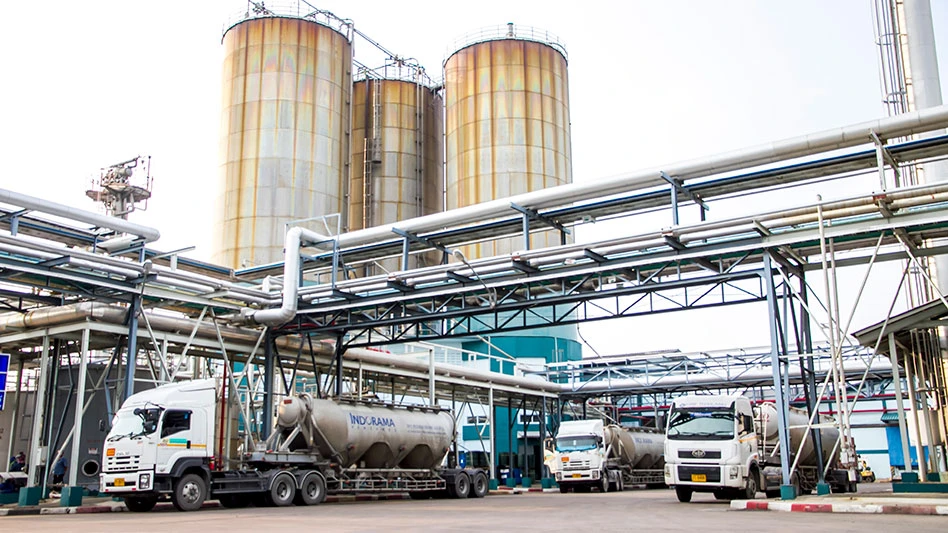
Photo courtesy of Indorama Ventures Public Co. Ltd.
Indorama Ventures Public Co. Ltd., a global chemical company headquartered in Bangkok, has announced a plan to evolve its business strategy in response to structural shifts in the chemical industry ahead of its March 5 Capital Markers Day (CMD).
Aloke Lohia, CEO of Indorama Ventures, says industry megatrends are resulting in fundamental long-term changes in global chemical markets. Subdued local demand in China is driving overcapacity and fueling cheap exports, while low feedstock prices in North America are adding to supply arising from increased competitiveness.
At the same time, macroeconomic and geopolitical headwinds are weighing on global consumption, affecting Indorama Ventures’ margins and volumes in its 2023 fiscal year and leading to a 53 percent decline in earnings. Feedstock prices in Western markets will increase over time as peak oil demand draws closer and refineries shut down, while the reverse will occur in emerging Asian markets as capacity rises, driving feedstock costs lower, he explains. Indorama Ventures’ integrated manufacturing model allows it to benefit from lower feedstock prices through "make or buy" strategies that reduce working capital and interest costs, according to the company.
RELATED: Critical to growth
The company plans to outline details of its new IVL 2.0 strategy during its CMD that allow it to adapt to these industry conditions, including deleveraging its business while right-sizing its operations and optimizing competitiveness to improve shareholder returns over the next three years. These changes will allow the company to emerge stronger as demand normalizes in the longer term. Indorama Ventures says it is accelerating the transformation programs it started in 2021, including implementing new data management tools and intelligent dashboards that allow its experienced managers to predict market changes in real time and respond to shifts more effectively.
“Change is a constant in our industry,” Lohia says. “We have embraced similar seismic events in our 30-year history and emerged stronger than before. In 2023, we recognized that the ecosystem has changed, and wat worked for us in the past will not work going forward. We had to devise a new strategy to operate successfully within the new ground rules, leveraging the highly successful global model we built over decades. In recent months, each of our businesses has undergone a stringent review, with detailed plans now in place to optimize our assets, processes and our organization and focus on enhancing earnings quality over the next three years.”
The company made roughly 50 acquisitions throughout 20 years, building its global model. Lohia says he is confident in the long-term growth potential of the business, which is tied to macroconsumer trends as populations grow and modernize and demand more sustainable products.
Under IVL 2.0, the company says it will optimize its asset footprint, improve cashflow and reduce debt levels as it prioritizes enhancing earnings quality and maximizing shareholder value by reducing net debt by $2.5 billion to roughly $4.3 billion in 2026, including generating $800 million in cash flow from operational improvements and a further $1.7 billion from strategic corporate actions, including divestments, asset actions and select business listings. These steps are aimed at reducing its debt to earnings before interest, taxes, depreciation and amortization ratio to less than 3x.
“Our new strategy is a significant financial pivot,” Lohia says. “Now that we have the scale, we will leverage our global footprint and strong client relationships and optimize our costs so that we can generate enhanced long-term sustainable profit growth. We are also deleveraging our balance sheet, which will give us more flexibility to restore our company to a more sustainable growth path based on strict capital discipline and international standards of leverage.”
The company has established four strategic objectives:
- optimizing assets to increase its operating rate from 74 percent to 89 percent, including moving to lower-cost facilities and right-sizing manufacturing capacity;
- launching Project Olympus 2.0, its cost optimization program, to unlock $450 million in run rate efficiency gains by 2026;
- selling noncore assets and other value-unlocking strategies to generate about $1.3 billion in cash proceeds; and
- leveraging its leadership in sustainability innovation to drive a $350 million per year value uplift.
Integrated Oxides and Derivatives (IOD), the newest of Indorama Ventures’ three business segments, will be renamed Indovinya as the company focuses its downstream portfolio in high-potential markets, such as home and personal care, crop solutions, coatings and solutions and energy and resources. In a related move, the segment’s Intermediate Chemicals assets, comprising integrated polyethylene oxide, integrated ethylene glycol and methyl tert-butyl ether, will move to Indorama Ventures’ Combined PET (CPET) segment.
As part of its asset optimization program, in Q423 Indorama undertook a $308 million noncash impairment of its partly completed purified terephthalic acid-polyethylene terephthalate plant in Corpus Christi, Texas, Corpus Christi Polymers LLC (CCP), which is on hold while the joint venture partners reassess its future. Indorama Ventures also says its succession planning program has identified the next generation of managers as its three business segments work to become increasingly independent operations.
CCP was formed in 2018 as a joint venture between Corpus Christi Holdings LLC, a subsidiary of Indorama Ventures; Dak Americas LLC, a subsidiary of Alpek, Monterrey, Mexico; and APG Polytech USA Holdings Inc., a subsidiary of Far Eastern New Century, Taipei, Taiwan.
Construction of the plant was affected by pandemic-related disruptions before resuming in the summer of 2022.
Latest from Recycling Today
- BMW Group, Encory launch 'direct recycling’ of batteries
- Loom Carbon, RTI International partner to scale textile recycling technology
- Goodwill Industries of West Michigan, American Glass Mosaics partner to divert glass from landfill
- CARI forms federal advocacy partnership
- Monthly packaging papers shipments down in November
- STEEL Act aims to enhance trade enforcement to prevent dumping of steel in the US
- San Francisco schools introduce compostable lunch trays
- Aduro graduates from Shell GameChanger program





